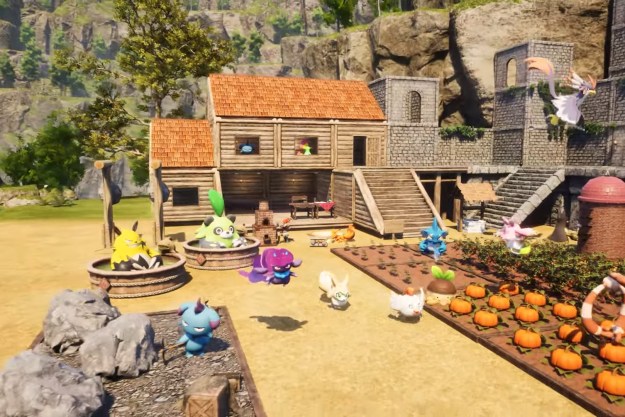It has been a long time since the last Wii Sports title, but Nintendo has finally given us a brand new collection of sports to play on our Nintendo Switches. Nintendo Switch Sports picks up right where the previous games left off, offering a host of sports that are easy to pick up and play thanks to being primarily, if not fully, motion-controlled with your Joy-Cons. Of the six sports included at launch, a few fan favorites from the Wii days are returning, most notably bowling and tennis, but we also get our first crack at some new sports activities like volleyball and chambara. Once again, there’s almost guaranteed to be a sport here that will be appealing to anyone, just like it was with Wii Sports.
While these sports games are meant to be easy to pick up and play, even for those who don’t typically play games often, they are all not only unique but have depth and tactics hidden under the surface for more dedicated players to uncover the longer you play. The natural competitiveness that comes with playing Nintendo Switch Sports with friends, or especially if you go online to challenge people around the world, can easily inspire you to up your game to take home as many victories as possible. If that sounds like you, here are all the best tips and tricks you need to dominate each sport in Nintendo Switch Sports.
See more
- The best Switch games for traveling
- The best party games for Nintendo Switch
- Can you play Switch Sports on a Nintendo Switch Lite?
Badminton tips and tricks
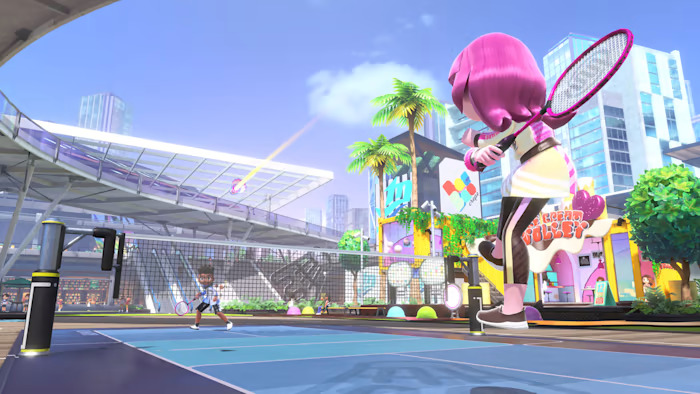
Going in alphabetical order of the sports included in Nintendo Switch Sports, badminton is up first. This may be a sport that fewer people are familiar with, though it shares many similarities to tennis and isn’t terribly hard to understand. The basics of the game are the same as tennis — to land the shuttlecock on the other side of the court without your opponent returning it. Each time you manage to do this, you earn one point. Whoever earns five points first wins the round. To do this, you have a few moves to vary how you hit and return the shuttlecock. Aside from your service, you can swing left or right, done simply by swinging the Joy-Con in that direction, do a smash shot by performing an overhead swing, or a drop shot by flicking the Joy-Con forward at head level while holding ZR or ZL.
The most important tip for badminton is to immediately take control of the pace of the match. If you can direct the flow of the game and force your opponent to scramble around the court just trying to return your shots, it will only be a matter of time before they slip up or can’t reach your next shot in time. To do this, you will need to master a few things. The first is to aim for the side of the court where your opponent isn’t. This will force them to need to reposition in order to hit the shuttlecock back. More than that, though, you want to mix up what types of shots you do. Smash shots and drop shots move at different paces, which can cause your opponent to panic. If they swing too carelessly, they can trip, which essentially makes your next shot a free point.
If you can force them to lob the shuttlecock back to you, that’s the time to do a super smash shot. Whenever you go for a smash, time your swing for when the shuttlecock is at the peak of its arc, which you can tell if you do it right since the trail it leaves will be orange. But be careful where you try to do a smash shot from. Smashing while you’re too close to the next can easily make your shot go out of bounds, thus losing you a point.
Bowling tips and tricks
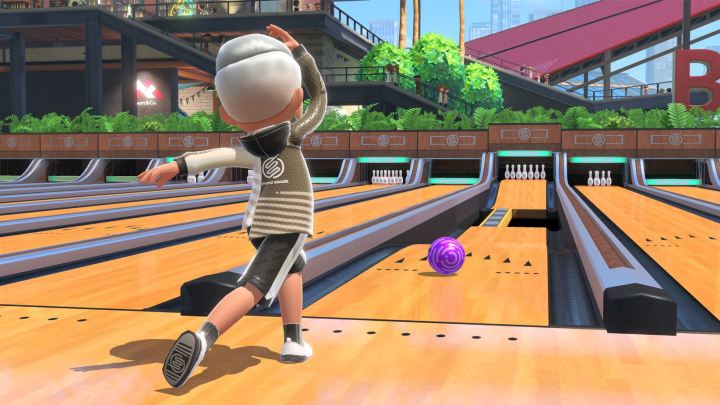
Almost everyone has gone bowling before, but if it does happen to be your first time, worry not. This game is as simple as rolling your ball down the lane and knocking down as many pins as possible. The more pins you knock down, the more points you get. You get two attempts per frame, with 10 frames in a standard game, with strikes, when you knock down all 10 pins on your first roll, and spares, knocking down all 10 by your second throw, giving you bonus points. If you get either a strike or spare on the final frame, you get either one or two more shots to gain even more points right at the end. The highest possible score, which you can only get by perfectly hitting all 12 possible strikes, is 300.
The only controls you need to worry about when bowling is the throw, aiming, and whether you put any spin on the ball. To put a spin on the ball, which will make it curve in one direction or the other as it rolls down the lane, you need to twist your wrist while performing the throw in the direction you want it to curve. Before you throw, though, you will position where your character stands and angle they face the lane.
Obviously, you will want to go for strikes in bowling as much as possible. To do this, you want to aim for the pocket between the single first pin and the pin directly behind it either on the right or left. To help you aim your shot, remember to press the X button to zoom in on the pins before you finish aiming your shot to make sure everything is lined up perfectly. This is especially important if you need to pick up a spare and need to target single pins. While advanced, the best tactic for getting strikes is to put some spin on your ball so it comes in at that pocket we mentioned at an angle. This leads to the best odds of the pins all cascading and knocking the entire set down.
If you get unlucky and are left with pins standing not near each other for your second throw, aim for the opposite edge of one pin to try and send it flying towards the other(s). It’s a very difficult shot but is your best bet to pick up the spare.
Tennis tips and tricks

Tennis will have a lot of carryover from the tips we mentioned for badminton, though does have plenty of unique aspects and rules that make it unique. Basically, tennis is about hitting the ball onto the opponent’s side of the court and having it bounce twice before they can hit and return it across the net to your side. If it bounces twice, isn’t hit over the net, or is hit out of bounds, you earn a point. Rather than scores going up by single points, you go from 0, 15, 30, 40, and win at 45. The exception is if you and your opponent both tie at 40, called deuce, in which case one team needs to score twice in a row in order to win the match. You can play single matches, best of three, or best of five. Tennis is always played in doubles, or 2-on-2, with no way to play singles.
Even if you’re playing alone, and thus controlling both characters on your side of the court, nothing about the controls or mechanics will be different. Just like the old Wii Sports version of tennis, your characters will automatically move around the court without you needing to direct them, letting you focus on the swings. For moves, you can do a normal serve by swinging the Joy-Con up and then down at the right time, a rocket serve if you hit the ball when it’s at the absolute highest point, and four different hits once you’re in a volley: a regular hit, topspin, backspin, and lob. Regular hits are done by just flicking the Joy-Con in the correct direction at the right time to send the ball back. Depending on when you hit the ball, it will alter its course. How fast you swing the Joy-Con will also dictate how hard your character hits the ball. Hitting it too hard may cause it to go out of bounds, and too light might not give it enough distance to clear the net.
Adding a topspin or backspin is done by twisting your wrist upwards or downwards respectively during that hit. Adding topspin will make the ball speed up once it bounces on the opponent’s side of the court, while backspins tend to be slower shots that have a shorter bounce that is hard to predict. Lobs, the last shot, is done by swinging in a straight upward motion. This will send the ball high up in a slow, large arc. These can be risky, but great for confusing your opponent’s timing and landing shots on the back row.
A unique aspect of tennis you also need to consider is the type of court you’re playing on. There are three types, and all seem to be picked at random before each match. Hard courts are the normal, pink courts that play like a regular court. Grass courts are green and make the ball have less bounce. Clay courts are the last type in brown. This type makes the ball lose speed after bouncing.
Always try and hit those rocket serves. These are way faster than normal ones, and if they catch your opponent by surprise, you can get a quick and easy point. During volleys, always try and aim your shots for the edges of the court as far from where your opponents are standing as possible. Like badminton, making your opponent run around back and forth will lead to your point as they struggle to keep up. Besides that, mix up your shots with regular, top, and backspin shots to catch your opponent off balance.
Soccer tips and tricks
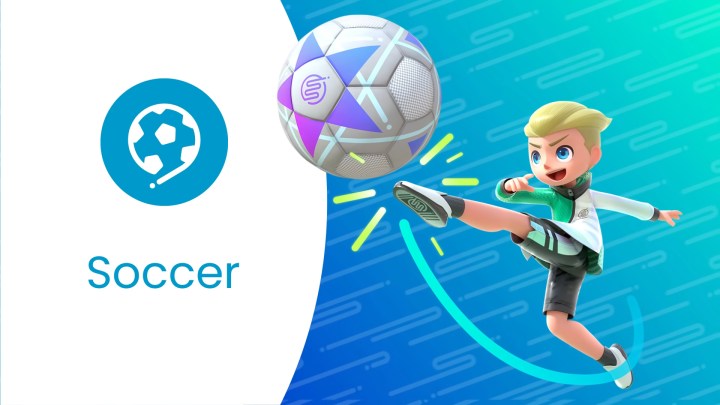
Soccer is an interesting inclusion in Nintendo Switch Sports and has been altered the most to be more accessible as a game than the other sports so far. The ball itself is huge, but otherwise, everything plays like traditional soccer. You just need to score the ball on the opponent’s goal more than they score on you. If one team gets four points ahead, the game ends there and they are declared the winner. Otherwise, the game will go on until the time expires, which is after two minutes in a one-on-one match or three minutes for four-on-four.
One big twist with soccer in Nintendo Switch Sports is the Golden Ball that appears usually in the ending moments of matches. Scoring with the Golden Ball is worth two points rather than one, which can very quickly shake up the scoreboard.
Controls for soccer are a bit more like a traditional game. You move with the analog stick, can control the camera, swing to kick, but can also pass, dash, jump, and ping teammates. Starting with kicking, there are three different kick types you can perform: overhead, low, and diagonal kicks. Overhead kicks are done by swinging your Joy-Con straight upward and will send the ball forward and slightly airborne. Low kicks and performed by doing the opposite — swinging from high to low. These kicks keep the ball tight and low to the ground. Diagonal kicks can be performed by swinging to either side and will curve send the ball in a, you guessed it, diagonal direction from your player. While not a kick, there is one final move you can do by swinging both Joy-Cons down simultaneously. Doing this will make your character dive forward for a header. This move actually hits the ball harder than a regular kick but is risky because you will have to wait for your character to get back up from the ground and it consumes stamina.
To pass, you will need to hold ZR while kicking to aim the ball towards the closest member of your team. Pressing or holding ZL will make your character dash, as long as they have stamina, and the B button makes you jump. If playing with a team, the A button will ping your teammate to signal that you’re open and want to be passed to.
Winning soccer comes down to managing your stamina and not giving up the ball in bad situations. Don’t just dash all the time for no reason and save it for when you’re pushing for a goal, or need to make a save. Always pass rather than try and brute force your way past opponents, or use diagonal kicks to keep the ball moving toward the opponent’s goal but deny them a steal if they’re coming to block you.
Chambara tips and tricks

A new addition to Nintendo Switch Sports, chambara is probably the one sport that few if any players will have prior familiarity with. Thankfully, it is very easy to understand. Essentially, this is a sumo wrestling match, only the two combatants strike each other with fake swords rather than bare hands to push each other toward the edge. Pushing your opponent into the water earns you one point, with the first player to reach two points being the winner. If no one falls after 45 seconds, that round is a draw. If the game comes to a draw after three rounds, there will be a sudden death round in which the platform is incredibly small and players will fall after getting hit only twice.
With your sword, you have either the option to attack or block. Landing attacks will push the opponent back, but a successful block will stun them and leave them open to an attack. All attacks and blocks can be either vertical, horizontal, or parallel. You can also perform a straight thrust attack by pushing the Joy-Con straight ahead. A successful attack means striking in a direction the opponent isn’t blocking, while a successful block is done by blocking in the correct direction. All of these moves are tied to how you swing or hold your Joy-Con, but you need to hold ZL/ZR to switch to a block stance. You can also strafe around slightly by tilting your Joy-Cons either left or right to better position yourself on the platform.
Before a match, you will also have your choice of three different sword types: Regular, charge, or twin. Regular swords have the standard moves, while charge and twin have unique skills. The charge sword can build up a charge by blocking attacks that you can use to do either a charge strike or charge thrust move by holding L/R while performing those moves. Each of these, if they hit, pushes much further than a regular hit. The twin swords, on the other hand, equip you with one sword per hand and the spinning strike and twin thrust moves. So, not only can you do normal attacks with each hand, but also swing both Joy-Cons together to do a flashing spinning strike once an energy meter fills up over time. Or you can use the charge to thrust both Joy-Cons forward for a double thrust.
Even though there are tons of attacks you can use and we all love the idea of motion-controlled sword fighting, chambara in Nintendo Switch Sports is all about defense. Holding block at all times, only letting go when you’re sure you’re ready to strike, is key. Attacking too frequently only makes your attacks get weaker the more you do. Watch your opponent, react to them, or surprise them with a quick strike where their guard is down. Even when neither of you is attacking, always try to position yourself closer to the center of the ring and keep them as close to the edge as possible. Experiment with each type of sword to see which you like best, but don’t get too focused on using special moves.
Volleyball tips and tricks
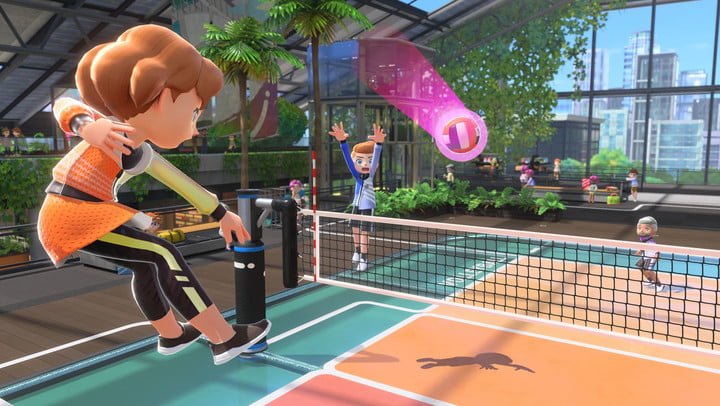
Last up we have the summertime hit: Volleyball. Nintendo Switch Sports makes this sport, like tennis, a two-on-two style game. You need to hit the ball up and over the net and try to land the ball on the other side of the court to earn a point without letting it fall on your side. The first team to score five points wins, but the same deuce rule of tennis applies here, where a team needs to win by at least two points.
Volleyball has a lot of moves that all serve a special purpose in a match. Let’s start with serving, which is done exactly like serving in tennis, which is by performing a downward swing with the Joy-Con. You can alter the properties of your service depending on the speed, timing, and angle of your swing. Once the ball is in play, we have a lot more to consider, specifically bumping, spiking, setting, and blocking.
Bumping is your most basic and important move in volleyball. By holding your Joy-Con in front of you and lifting it upward from your waist, you will launch the ball up to make it easy for your teammate to follow up with their own hit. Setting the ball is the next piece of the puzzle, so to speak. By holding your Joy-Con up by your head and pressing it upward, you will bounce the ball up, but not over the net. Instead, this move is to set up your teammate for a spike. When it’s time to spike, all you need to do is a big, sweeping down motion when your character leaps up into the air and the ball comes close enough to hit. The better you time this smash, the faster the ball will hurtle toward the ground. If you’re about to get hit with a spike you will need to block by raising your hands straight up to leap up and try to intercept the ball. If you time it right, you can even get the ball to ricochet right back to the opponent’s side for an easy point.
Unlike tennis, you do have to worry about moving your character in volleyball. You can only shift left or right, but you want to always be in a position where you think the ball is going to be going. Otherwise, volleyball is very kind and will actually give you directions as to what moves you should be doing at the top of the screen. When the ball is on its way over, for example, it will tell you to do a bump. Once you know what to do, try and swing with perfect timing to keep the ball in control. If you do it just right, you will get a “Nice!” prompt on the screen. There’s also one special move you can use if you find yourself just out of reach of a ball, which is to dive. This is a risky move but can save you a point. To dive, just shake the Joy-Con and your character will leap for the ball, potentially saving it, but also leave you on the ground for a second until you get back up. Beyond that, just try and hit the ball fast and hard in the open spaces as far from your opponents as possible.
Editors' Recommendations
- Nintendo Switch 2: release date rumors, features we want, and more
- Best Nintendo Switch deals: consoles, games, and accessories
- How to transfer data from Nintendo Switch to Switch OLED
- Nintendo Switch Game Vouchers: how they work and eligible games
- Everything you need to know about Nintendo Switch Online




